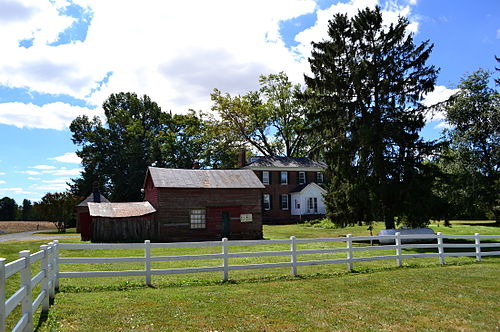Temple Hall | |
 | |
| Location | 15764 Temple Hall Lane, Leesburg,Virginia |
|---|---|
| Coordinates | 39°10′54.39″N77°31′43.55″W / 39.1817750°N 77.5287639°W /39.1817750; -77.5287639 |
| Area | 286 acres (116 ha) |
| Built | 1810 |
| Architectural style | Federal style |
| NRHP reference No. | 07000053[1] |
| VLR No. | 053-0303 |
| Significant dates | |
| Added to NRHP | February 13, 2007 |
| Designated VLR | September 6, 2006; May 15, 2007[2] |
Temple Hall is an early 19th-centuryFederal-stylemansion and working farm near thePotomac River north ofLeesburg inLoudoun County,Virginia.
Temple Hall was constructed in 1810[3] forWilliam Temple Thomson Mason (24 July 1782–1862),[4] a son ofThomson Mason and his second wife Elizabeth Westwood Wallace of nearbyRaspberry Plain, and nephew ofGeorge Mason.[5] The estate became a hub of Leesburg society[6] and was visited byGilbert du Motier, marquis de Lafayette during hisgrand tour of the United States on 9 August 1825.[5][6] Lafayette was accompanied byPresidentJohn Quincy Adams and former PresidentJames Monroe, who was then residing at hisOak Hillplantation in southern Loudoun County.[5] The three gentlemen witnessed thebaptism of Mason's two youngest daughters at Temple Hall with Lafayette serving as godfather for Mary Carroll, and Adams and Monroe serving as Maria Louisa's godfathers.[5][6][7] Altogether, Mason and his wife, Ann Eliza Carroll, raised ten children at Temple Hall.[6] In addition to the Mason family, approximately twenty enslavedAfrican-Americans resided on the property.[6] Under Mason's management, the Temple Hall estate was a modestly successful farm.[6] Mason cultivatedorchards and raised corn, wheat, and livestock.[6]
Mason retired toWashington, D.C. in 1857[6] and sold his farm to Henry A. Ball, who farmed it with using approximately 20 enslaved young men, 17 under age 16.[8] Ball favored secession, and after Virginia voted for secession as theAmerican Civil War began, two of Henry Ball's enlisted in theConfederate States Army's cavalry.[1] In 1862, Henry Ball was arrested for refusing to take an oath of allegiance to theFederal Government.[6] Ball was released after spending nearly a year in theOld Capitol Prison.[6]John S. Mosby visited Temple Hall on 5 July 1864 and dined with the Ball family.[6] While at the house, Mosby received information that led to theaction at Mount Zion Church.[6] Temple Hall remained in the Ball family until 1878 when it was sold at auction.[6]
In 1940, after a succession of owners, the Temple Hall property was purchased by Mr. and Mrs. James H. Symington.[9] The Symingtons restored the mansion and made extensive renovations.[9] They modernized Temple Hall by adding indoor plumbing and electricity.[9] The Symingtons planted a variety of crops and eventually began specializing inpopcorn.[9] They became the largest suppliers in the eastern United States until the popcorn market collapsed afterWorld War II.[9] Afterwards, the Symingtons turned to raisinglivestock, including cattle and hogs, as well as wheat, corn, and hay for animal feed.[9] Mrs. Symington assumed management of the farm's operations after her husband became ill in the 1970s, and continued to operate it after his death.[9] Concerned about Loudoun County's rapid development and population growth, Mrs. Symington donated the 286 acre[10] farm to theNorthern Virginia Regional Park Authority (NVRPA) in 1985.[9] Since then, the NVRPA has operated Temple Hall as a working farm and interpretive center.[9][10] Temple Hall, along with several neighboring estates including nearby Mason family estateRaspberry Plain, is a contributing property in the 25,000-acre (10,000 ha)Catoctin Rural Historic District, which was added to theNational Register of Historic Places on 31 January 1989.[5] Temple Hall was listed on the National Register on 13 February 2007.
Temple Hall is an early 19th-centuryFederal-style mansion.[5] It is aFlemish bond brick house with a five-bayfacade and is topped by ahipped roof.[5] A smallDoricportico shelters the central entrance which is surmounted by a graceful semicircularfanlight.[5] Temple Hall also exhibits tall six-over-six double-sash windows, afrieze encircling the building, and tall interior endchimneys.[5] The property also features a square bricksmokehouse and two 19th-centuryframebarns.[5]